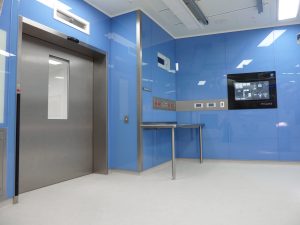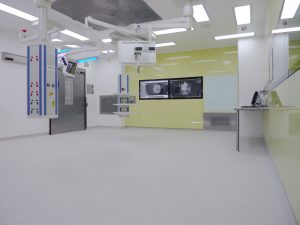Modular construction has been used in hospital and laboratory builds for many years overseas, however, it is still relatively new to the Australian market.
Perth Children’s Hospital came to the forefront of this space by using modular construction across 12 operating theatres, corridors and post-surgery/prep areas. This method ensures that future upgrades and device integration can be applied seamlessly, with limited disruption to the hospital’s daily operations. A special feature of this project was the extensive planning with BIM programming so that all individual parts and essential services were combined and overlaid, giving a complete picture before anything was signed off. Managing Director of Hospital Products Australia, Shawn Wigham was the sales and modular construction lead and has firsthand experience with large scale projects.
 What is Modular Construction?
What is Modular Construction?
In recent times, prefabricated (or prefab) has become one of the most widely-used forms of commercial construction. It allows for the disparate parts of a building or structure to be manufactured off-site, before being transported and constructed on location.
Although prefab and modular construction are often used interchangeably, one is actually a subsection of the other. While prefab refers to any project where parts are manufactured off-site, modular construction specifically refers to the creation of “modules” that can then be transported and connected together on location.
When compared to other commercial construction methods, modular construction generates less waste, creates fewer site disturbances, and allows projects to be completed significantly faster without the risk of accidents and other liabilities for those involved in the manufacturing process.
 What Does Modular Construction Offer the Health Sector?
What Does Modular Construction Offer the Health Sector?
The health sector poses a unique set of challenges within the construction industry due to the large number of highly complex medical installations and services that are needed to provide essential care. This, coupled with a consistent need for upgrades and new equipment, means that a high level of versatility is required from any modules that form the hospital’s framework.
Due in part to these factors, modular construction has become a preferred choice for new hospitals. Components are produced off-site to exact room requirements, allowing the on-site crew to install the parts in an organised sequence, co-ordinated with essential services and medical fittings. Resulting in a shorter build schedule with less room for error.
As touched on earlier, the production of individual modules, rather than one fully-connected building, makes modular construction highly adaptable for any future extensions. This will likely prove invaluable as the hospital expands to accommodate the needs of patients. Whether the facility needs to be redesigned or moved entirely in the future, this method of construction provides an easy solution for any eventuality.
Modular Systems
Thanks to companies like Hospital Products Australia (HPA), the modular method of development is also utilised in several other areas of hospital development, such as operating room controls and sterilisation departments. These modular systems are perfectly suited to both hospitals and laboratories, as the manufacturer acts as a single-source, thereby avoiding the need for multiple contractors and minimising the chance of any potential contamination.
Considering all of the benefits offered by this process, it’s no wonder that modular construction has become one of the most popular methods of commercial construction. Plus, with the near-limitless number of design possibilities available through prefab manufacturing, we’re sure to see a lot more projects utilising modular methods in the future.

 What is Modular Construction?
What is Modular Construction? What Does Modular Construction Offer the Health Sector?
What Does Modular Construction Offer the Health Sector?